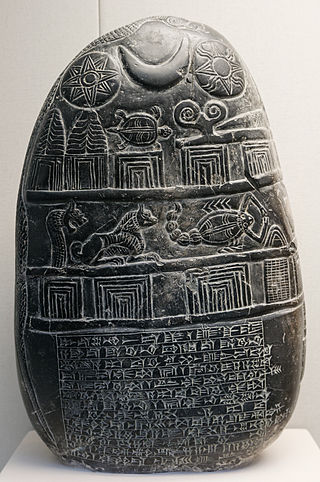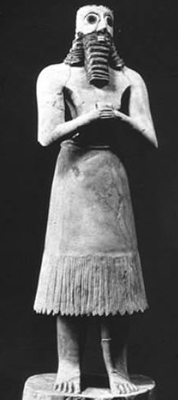Related Research Articles
Nintinugga was a Mesopotamian goddess associated with medicine and cleansing. She belonged to the local pantheon of Nippur. While she has been compared to other similar goddesses, such as Ninisina and Gula, and in a number of ancient texts they appear to be syncretised with each other or are treated as interchangeable, she was nonetheless a distinct deity in her own right. She was associated with Enlil and Ninlil, and was worshiped in their temples, though houses of worship dedicated only to her are also attested.

Shala (Šala) was a Mesopotamian goddess of weather and grain and the wife of the weather god Adad. It is assumed that she originated in northern Mesopotamia and that her name might have Hurrian origin. She was worshiped especially in Karkar and in Zabban, regarded as cult centers of her husband as well. She is first attested in the Old Babylonian period, but it is possible that an analogous Sumerian goddess, Medimsha, was already the wife of Adad's counterpart Ishkur in earlier times.

Ištaran was a Mesopotamian god who was the tutelary deity of the city of Der, a city-state located east of the Tigris, in the proximity of the borders of Elam. It is known that he was a divine judge, and his position in the Mesopotamian pantheon was most likely high, but much about his character remains uncertain. He was associated with snakes, especially with the snake god Nirah, and it is possible that he could be depicted in a partially or fully serpentine form himself. He is first attested in the Early Dynastic period in royal inscriptions and theophoric names. He appears in sources from the reign of many later dynasties as well. When Der attained independence after the Ur III period, local rulers were considered representatives of Ištaran. In later times, he retained his position in Der, and multiple times his statue was carried away by Assyrians to secure the loyalty of the population of the city.

Nirah was a Mesopotamian god who served as the messenger (šipru) of Ištaran, the god of Der. He was depicted in the form of a snake.
Pabilsaĝ was a Mesopotamian god. Not much is known about his role in Mesopotamian religion, though it is known that he could be regarded as a bow-armed warrior deity, as a divine cadastral officer or a judge. He might have also been linked to healing, though this remains disputed. In his astral aspect, first attested in the Old Babylonian period, he was a divine representation of the constellation Sagittarius.
Ninazu was a Mesopotamian god of the underworld of Sumerian origin. He was also associated with snakes and vegetation, and with time acquired the character of a warrior god. He was frequently associated with Ereshkigal, either as a son, husband, or simply as a deity belonging to the same category of underworld gods.

Abu was a Mesopotamian god. His character is poorly understood, though it is assumed he might have been associated with vegetation and with snakes. He was often paired with the deity gu2-la2, initially regarded as distinct from Gula, but later conflated with her.
Ningirida was a Mesopotamian goddess regarded as the wife of Ninazu and mother of Ningishzida. Little is known about her character beyond her relation to these two gods.
Ama-arḫuš was a Mesopotamian goddess associated with compassion and healing or epithet of goddesses designating them as compassionate.
Duttur was a Mesopotamian goddess best known as the mother of Dumuzid. She frequently appears in texts mourning his death, either on her own or alongside Geshtinanna and Inanna. It is often assumed that she was associated with sheep.
Tishpak (Tišpak) was a Mesopotamian god associated with the ancient city Eshnunna and its sphere of influence, located in the Diyala area of Iraq. He was primarily a war deity, but he was also associated with snakes, including the mythical mushussu and bashmu, and with kingship.

Ninkarrak was a goddess of medicine worshiped chiefly in northern Mesopotamia and Syria. It has been proposed that her name originates in either Akkadian or an unidentified substrate language possibly spoken in parts of modern Syria, rather than in Sumerian. It is presumed that inconsistent orthography reflects ancient scholarly attempts at making it more closely resemble Sumerian theonyms. The best attested temples dedicated to her existed in Sippar and in Terqa. Finds from excavations undertaken at the site of the latter were used as evidence in more precisely dating the history of the region. Further attestations are available from northern Mesopotamia, including the kingdom of Apum, Assyria, and the Diyala area, from various southern Mesopotamian cities such as Larsa, Nippur, and possibly Uruk, as well as from Ugarit and Emar. It is possible that references to "Ninkar" from the texts from Ebla and Nikarawa, attested in Luwian inscriptions from Carchemish, were about Ninkarrak.

Ninisina was a Mesopotamian goddess who served as the tutelary deity of the city of Isin. She was considered a healing deity. She was believed to be skilled in the medical arts, and could be described as a divine physician or midwife. As an extension of her medical role, she was also believed to be capable of expelling various demons. Her symbols included dogs, commonly associated with healing goddesses in Mesopotamia, as well as tools and garments associated with practitioners of medicine.
Ashgi was a Mesopotamian god associated with Adab and Kesh. While he was originally the tutelary deity of the former of these two cities, he was eventually replaced in this role by his mother Ninhursag, locally known under the name Digirmah. He is mostly attested in sources from before the Old Babylonian period.

Gula was a Mesopotamian goddess of medicine, portrayed as a divine physician and midwife. Over the course of the second and first millennia BCE, she became one of the main deities of the Mesopotamian pantheon, and eventually started to be viewed as the second highest ranked goddess after Ishtar. She was associated with dogs, and could be depicted alongside these animals, for example on kudurru, and receive figurines representing them as votive offerings.
Ašratum was a Mesopotamian goddess of Amorite origin. She was regarded as the wife of the god Amurru. Her name is a cognate of Ugaritic Athirat, but despite likely sharing the same origin these two goddesses occupied different positions in the respective pantheons.
Alammuš (Alammush) was a Mesopotamian god. He was the sukkal of the moon god Nanna, and like him was worshiped in Ur. He was also closely associated with the cattle god Ningublaga, and especially in astronomical texts they could be regarded as twin brothers.
Ninmada was a name applied to two separate Mesopotamian deities, a god and a goddess. The female Ninmada was a divine snake charmer, and in the myth Enki and Ninmah she appears as an assistant of the eponymous goddess. The male Ninmada was called the "worshiper of An" and was regarded as a brother of the snake god Ninazu. It is assumed that these deities could be partially conflated with each other or shared a similar origin, though proposals that there was only one Ninmada are also present in modern scholarship.
Meme or Memešaga was a Mesopotamian goddess possibly regarded as a divine caretaker. While originally fully separate, she eventually came to be treated as one and the same as Gula, and as such came to be associated with medicine. The god list An = Anum additionally indicates she served as the sukkal of Ningal.
Latarak (Lātarāk) was a Mesopotamian god. He was most likely depicted as a figure clad in a lion's skin, or perhaps as a lion-like monster. He was regarded as a protective deity, invoked to defend doorways and ward off diseases. He was closely associated with Lulal, though the relationship between them varies between available primary sources, with some equating them and other treating them as a pair of similar, but not identical deities. He was worshiped in Mesopotamian cities such as Uruk, Nippur and Assur. It is also possible that a city named after him, Bāb-Lātarāk, existed, but the reading of this toponym is not certain. Outside Mesopotamia, he is attested in religious texts from Emar and in a trilingual god list from Ugarit.
References
- ↑ Sibbing-Plantholt 2022, p. 28.
- 1 2 3 4 5 6 7 Krebernik 2014, p. 301.
- 1 2 3 4 5 Wiggermann 1989, p. 120.
- 1 2 3 4 Sibbing-Plantholt 2022, p. 41.
- 1 2 3 4 Sibbing-Plantholt 2022, p. 40.
- 1 2 3 Wiggermann 1998, p. 331.
- ↑ Sibbing-Plantholt 2022, pp. 39–40.
- 1 2 Sibbing-Plantholt 2022, p. 42.
- ↑ Sibbing-Plantholt 2022, p. 32.
- ↑ Sibbing-Plantholt 2022, p. 43.
- ↑ Sibbing-Plantholt 2022, p. 44.
- 1 2 3 4 Sibbing-Plantholt 2022, p. 39.
Bibliography
- Krebernik, Manfred (2014), "Ukulla, Kulla(b)", Reallexikon der Assyriologie (in German), retrieved 2022-08-14
- Sibbing-Plantholt, Irene (2022). The Image of Mesopotamian Divine Healers. Healing Goddesses and the Legitimization of Professional Asûs in the Mesopotamian Medical Marketplace. Boston: Brill. ISBN 978-90-04-51241-2. OCLC 1312171937.
- Wiggermann, Frans A. M. (1989). "Tišpak, his seal, and the dragon mušḫuššu". To the Euphrates and beyond: archaeological studies in honour of Maurits N. van Loon. Rotterdam Brookfield, VT: CRC Press. ISBN 978-90-6191-866-0. OCLC 20332607.
- Wiggermann, Frans A. M. (1998), "Nin-azu", Reallexikon der Assyriologie, retrieved 2022-08-14